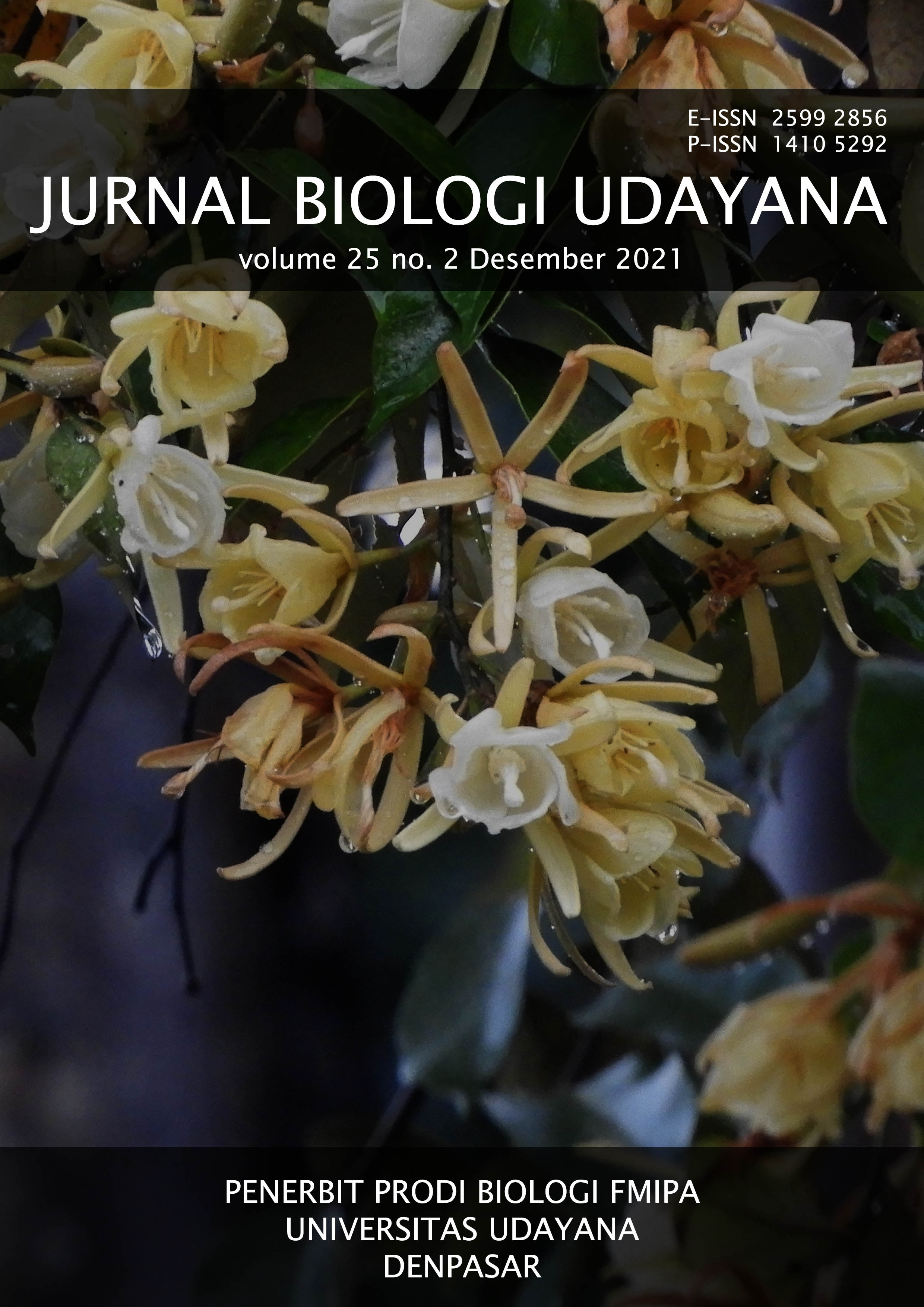Potential of Streptomyces sp. in preventing the in vitro growth of Colletotrichum acutatum, the causative agent of infection in Capsicum annum L.
Abstract
Red chilli plant (Capsicum annum L.) is one of the most popular vegetable crops in Indonesian society. One of them the pathogens attacks is Colletotrichum acutatum, a fungus causing anthracnose on red chilli. This study aims to determine the existence of Streptomyces sp. bacteria in the rhizosphere of the red chilli plant; the ability of Streptomyces sp. in inhibiting C. acutatum; Minimum Inhibitory Concentration (MIC) of Streptomyces isolates extracts in inhibiting C. acutatum; The Streptomyces isolation was carried out by dilution method using selective meida, namely Yeast Malt Agar. The Dual Culture method was used as an inhibition test between Streptomyces sp. and C. acutatum in vitro. A well diffusion method was used to test the effectiveness of the Streptomyces sp. and MIC filtrate concentration in inhibiting C. acutatum. The data obtained in this study were analyzed with Analysis of Varian (ANOVA) then continued with Duncan Multiple Range Test with 5% significance. Five Streptomyces isolates were found, namely Streptomyces sp.1, Streptomyces sp.2, Streptomyces sp.3, Streptomyces sp.4, and Streptomyces sp.5 in the rhizosphere of healthy C. annum L. plants in Daup Village, Kintamani District, Bangli Regency. Streptomyces sp. isolates. can significantly inhibit the growth of the fungus C. acuatum with inhibitory power ranging from 50.30% to 83.76%, Streptomyces sp.5 isolate was able to provide the highest percentage of inhibition in C. acutatum of 83.76 ± 2.91% with MIC 7% (v/v) with a diameter of 6.40 mm.
Downloads
References
Anggraeni W, Wardoyo ERP, Rahmawati. 2019. Isolasi dan Identifikasi Jamur Pada Buah Cabai rawit (Capsicum frutescens L.) yang Bergejala Antraknosa Dari Lahan Pertanian Di Dusun Jeruk. Jurnal Protobiont. 8(2): 94:100.
Cihak M, Kamenik Z, Smidova K, Bergman K, Benada O, Kofronova O, Petricknova K, Bobek J. 2017. Secondary Metabolites Produced during the Germination of Streptomyces coelicolor. Frontiers in Microbiology. 2495(8): 1-8.
Crous PW, Verkley GJM, Groenewald JZ, Samson RA. 2009. Fungal Biodiversity. CBS KNAW Fungal Biodiversity Center Utrecht, the Netherlands.
Gu L, Zhang K, Zhang N, Li X, Liu Z. 2020. Control of the Rubber Anthracnose Fungus Colletotrichum gloeosporioides using Culture Filtrat Extract from Streptomyces deccanensis QY-3. 113(11): 1573-1585.
Holt JG, Krieg NP, Sneath PHA, Staley JT, Williams ST. 1994. Bergey’s Manual of Determinative Bacteriology. 9th Edition. Lippincott Williams and Wilkins. New York
Ibrahim R, Hidayat SH, Widodo. 2017. Keragaman Morfologi, Genetika, dan Patogenisitas Colletotrichum acutatum Penyebab Antraknosa Cabai di Jawa dan Sumatera. Jurnal Fitopatologi Indonesia. 13(1): 9-16.
Kawuri R. 2012. Pemanfaatan Streptomyces thermocarboxydus untuk Mengendalikan Penyakit Busuk Daun pada Lidah Buaya (Aloe barbadensis Mill.) di Bali. (Disertasi). Universitas Udayana. Bali.
Kawuri R, Suprapta DN, Nitta Y. 2018. Antagonistic Activity of Streptomyces thermocarboxydus to Fusarium oxysporum: The cause of Leaf Rot Disease on Aloe Vera (Aloe barbadensis Mill.) in Bali, Indonesia. Malaysian Journal of Microbiology. 10-15.
Khamna S, Yokota A, Lumyong S. 2009. Actinomycetes Isolated from Medicinal Plant Rhizosphere Soil: Diversity and Screening of Antifungal Compound, Indole-3-Acetic Acid and Siderophore Production. World Journal Microbiology and Biotechnology. 25(4):649-655.
Kumalasari AM, Fathurahman N, Nur M. 2012. Potensi Actinomycetes Sebagai Sumber Senyawa Bioaktif Antibiotik dari Kawasan Karst Bantimurung, Sulawesi Selatan. Pelita-Jurnal Penelitian Mahasiswa UNY. 7(1): 59-72.
Montoc HS. 2011. Uji Antagonisme Saccharomyces sp. dan Pseudomonas aeruginosa Terhadap Sembilan Jamur Patogen. Jurusan Hama dan Penyakit Tumbuhan. Skripsi Sarjana. Fakultas Pertanian. Universitas Udayana
Muthahanas I, Listiana E. 2017. Skrining Streptomyces sp. Isolat Lombok Sebagai Pengendali Hayati Beberapa Jamur Patogen Tanaman. CROP AGRO Scientific Journal of Agronomy. 1(2): 130-136.
Nellawati NLCA, Kawuri R, Arpiwi NL. 2016. Uji Daya Hambat Streptomyces roseoflavus AL2 Terhadap Xanthomonas sp. Penyebab Penyakit Hawar Daun Bakteri (HBD) pada Tanaman Padi (Oryza sativa L.). Metamorfosa: Journal of Biological Sciences. 3(1): 1-7.
Nguyen XH, Naing KW, Lee YS, Kim YH, Moon JH, Kim KY. 2015. Antagonism of Antifungal Metabolites from Streptomyces griseus H7602 against Phytophthora capsici. Journal of Basic Microbiology. 55(1): 45-53.
Nurkanto A, Listyaningsih F, Julistiono H, Agusta A. 2010. Eksplorasi Keanekaragaman Aktinomisetes Tanah Ternate Sebagai Sumber Antibiotik. Jurnal Biologi Indonesia. 6(3): 325-339.
Palaniyandi SA, Yang SHD, Cheng JH, Meng L, Suh JW. 2011. Biological control of anthracnose (Colletotrichum gloeosporioides) in yam Streptomyces sp. MJM5763. Journal of applied microbiology. 111(2): 443-455.
Pertiwi PH, Lukiswanto BS, Rochmah K. 2015. Isolasi dan Identifikasi dan Penapisan Aktivitas Antimikroba Streptomyces sp. Isolat Tanah Lumpur Lapindo Sidoarjo. Veterinari Medika. 8(1): 51-58.
Purnomo E, Mukarlina, Rahmawati. 2017. Uji Antagonis Bakteri Streptomyces spp. Terhadap Jamur Phytophthora palmivora BBK10 Penyebab Busuk Buah pada Tanaman Kakao. Protobiont. 6(3): 1-7.
Ramazani A, Moradi S, Sorouri R, Javani S, Garshasbi M. 2013. Screening for Antibacterial Activity of Streptomyces Species Isolated from Zanjan Province, Iran. IJPCBS. 3(2): 342-349.
Sari DR. 2015. Isolasi dan Identifikasi Bakteri Tanah yang Terdapat di Sekitar Perakaran Tanaman. Jurnal Bio-Site. 1(1): 21-27.
Sari NM, Kawuri R, Khalimi K. 2012. Streptomyces sp. Sebagai Biofungisida Patogen Fusarium oxysporum (Schlecht) f.sp. lycopersici (Sacc.) Snyd. Et Hans. Penyebab Penyakit Layu pada Tanaman Toman (Solanum lycopersicum L.). Agrotrop: Journal on Agriculture Science. 2(2): 161-169.
Soeka YS, Triana, E. 2016. Pemanfaatan Limbah Kulit Udang untuk Menghasilkan Enzim Kitinase dari Streptomyces macrosporeus InaCC A454. Jurnal Kimia Terapan Indonesia (Indonesian Journal of Applie Chemistry). 18(1): 91-101
Sumardiyono C, Joko T, Kristiawati Y, Chinta YD. 2011. Diagnosis dan Pengendalian Penyakit Antraknosa pada Pakis dengan Fungisida. Jurnal Hama dan Penyakit Tumbuhan Tropika. 11(2): 194-200.
Tsurayya S, Kartika L. 2015. Kelembagaan dan Strategi Peningkatan Daya Saing Komoditas Cabai Kabupaten Garut. Jurnal Manajemen & Agribisnis. 12(1): 1-13.
Whipps JM. 1987. Effect of Media on Growth and Interactions between a Range of Soil-Borne Glasshouse Pathogens and Antagonistic Fungi. The New Phytologist. 107(1): 127-142.
Widyanti N, Giyanto. 2013. Kemampuan Aktinomiset Menghambat Pertumbuhan Sclerotium rolfsii dan Pembiakannya pada Medium Serbuk Gergaji. Jurnal Fitopatologi Indonesia. 9(1): 7-14.
Yurnaliza Y, Margino S, Sembiring L. 2011. Kemampuan Kitinase Streptomyces RKt5 sebagai Antijamur terhadap Patogen Fusarium oxysporum. Jurnal Natur Indonesia. 14(1): 42-46.
Yutthasin R, Thummabenjapone P, Hiransalee A. 2015. Antagonistic Streptomyces Selection to Broad Spectrum for Biological Control of Colletotrichum spp., Causal Agent of Anthracnose in Chilli. Journal of Pure and Applied Microbiology. 9(4): 2705-2715.








